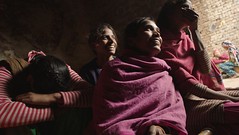CAPTIVE STATE
Directing: C
Acting: B
Writing: C-
Cinematography: B-
Editing: C+
Special Effects: C
Usually when a movie is getting mixed reviews, I can pretty easily tell what it is the people who liked it saw in it. Not so with Captive State, which certainly made me feel like a captive, and that’s about as effective as I can call it. Is it possible half the people who saw this movie liked it on some level just because they have no taste? Or brains? Some people are happy to be entertained by anything that happens to move on a screen, after all.
This movie is all setup, and then . . . the end. Spoiler alert: after one hundred nine minutes, there is no payoff whatsoever. It’s the story of an insurgency of inner city human captives to an invading alien race, nine years after first contact, preparing to make their move. A move gets made, and then you find out that wasn’t really the move. Something much deeper and more intricate is going on! Before we get to see that, though — the credits roll.
I’d say that I have a lot of questions, except that I left this movie relieved that it was over and preferring not to keep thinking about it. It was just so boring. But, I suppose I have some space to fill here. I’ll share some of my questions.
What’s the point of this alien race only taking over all the major cities in the world? I mean, I know the global population is more and more urbanized as time goes on, but rural populations still exist. What are those people doing? Are they just living peaceful lives, but for an inability to contact family in the cities? Also, what about the farming infrastructure that feeds those in the cities? How do goods come and go?
Don’t get me wrong — plenty of movies are great even with massive plot holes. It’s rare that plot holes don’t exist. But the point of making the audience overlook them is to offer a story so compelling that you don’t care. Captive State is so tedious that I had no choice but to spend a lot of time thinking about these things.
During the opening credits, white text on black computer screen tells us what’s going on, the way society has been affected by this alien race taking over any and all government functions. “The gap between rich and poor has never been wider,” it says. How original.
Writer-director Rupert Wyatt, who brought us the objectively superior (but still just . . . fine) Rise of the Planet of the Apes in 2011, seems to be going for some kind of subtle social commentary here. He aims and misses. Hell, he barely aims. Only in very occasional moments does something relevant to such a concept get said or done. For instance, a detained teenager (Ashton Sanders, the best thing in this movie) tells a Chicago police officer (John Goodman, plainly just getting a paycheck) he wants a lawyer. The response is, “You and I both know those days are gone.” This exchange is in the trailer, clearly to suggest there is something more to this. Turns out there isn’t.
I went into Captive State knowing it woudn’t be great, but thinking I might still be entertained. I wanted it to have more thrills. It has none. It makes an extended attempt at suspense, which ultimately falls flat. I wanted to see more of the aliens, which have a pseudo-humanoid shape which can turn into countless spikes at will. The screen time of these creatures — or “roaches,” as the humans call them — clocks in easily under five minutes. The rare times they do appear onscreen, the lighting is always incredibly dim and the special effects are still noticeably substandard.
There’s a couple wide shots of downtown Chicago, downtown being the “zone” where humans aren’t allowed at all, only the aliens. No explanation for this is ever given, and it kind of defies logic. We are told humans are subjected to indentured servitude to help construct an “underground habitat” for them, but that’s it. The objective of the humans is always to “regroup” and “fight back.” It would be a lot easier to root for them if the impetus for this entire scenario actually made sense.
In short: I don’t get it. And I don’t care to.
This kid deserves to be in a better movie.
Overall: C


















